Severance is hands-down the best show to come out this year (sorry to Station Eleven) and arguably the most thought-provoking Sci-Fi show since Hulu’s Devs. From the very first scene, it’s clear Severance is not interested in being the kind of show you half-watch in between glances at your phone. It demands constant attention, with weird bits of lore strewn about in each episode for the viewer to collect and begin to piece together the world of Severance.
It’s a show that explores the severing of the mind and the ramifications of undergoing such an unnatural process. The process allows a person to live two lives; one life that exists in the outside world as before and one that only exists in the workplace, with neither mind able to access the other. That sounds like a wonderful idea, but, like everything else in the show, it’s duplicitous. That concept of splitting the mind, of duality, runs deep, from the actors each playing two different people, to the change between the office setting and the outside world. .jpg?width=1600&name=image%201%20(2).jpg) The founder of Lumon, Kier Egan, looms over employees in the lobby of Lumon’s office building. Image via AppleTV+.
The founder of Lumon, Kier Egan, looms over employees in the lobby of Lumon’s office building. Image via AppleTV+.
Though the casting is nothing short of spectacular and the writing hooks you from the start, the Lumon office gives Severance its unsettling edge. There’s an insidious, haunting purpose to the design that is hidden behind the thin minimalist veneer. It wouldn’t be the same show without the eerie, sterile hallways, the lack of natural light, the weird office parties, or the therapy room. So, while the Lumon office is an office like any other, it’s also a prison. And it’s the vision of the architects of this corporate prison that is worth exploring.
Caution: there are spoilers for Severance below.
Producing the Corporate Horror of Severance
It’s a surprise any show gets greenlit, but when a show finally gets the go-ahead, it’s the producer's job to get things moving to deliver the show on time and within budget. As we’ve covered in a previous post, there are many producers on set, but when it comes to handling the day-to-day production tasks, that’s the job of the unit production manager. In the case of Severance, the unit production manager was Kristyn Macready, who keeps a low profile. However, the set designer Jeremy Hindle spoke to several publications about what went into making the show.
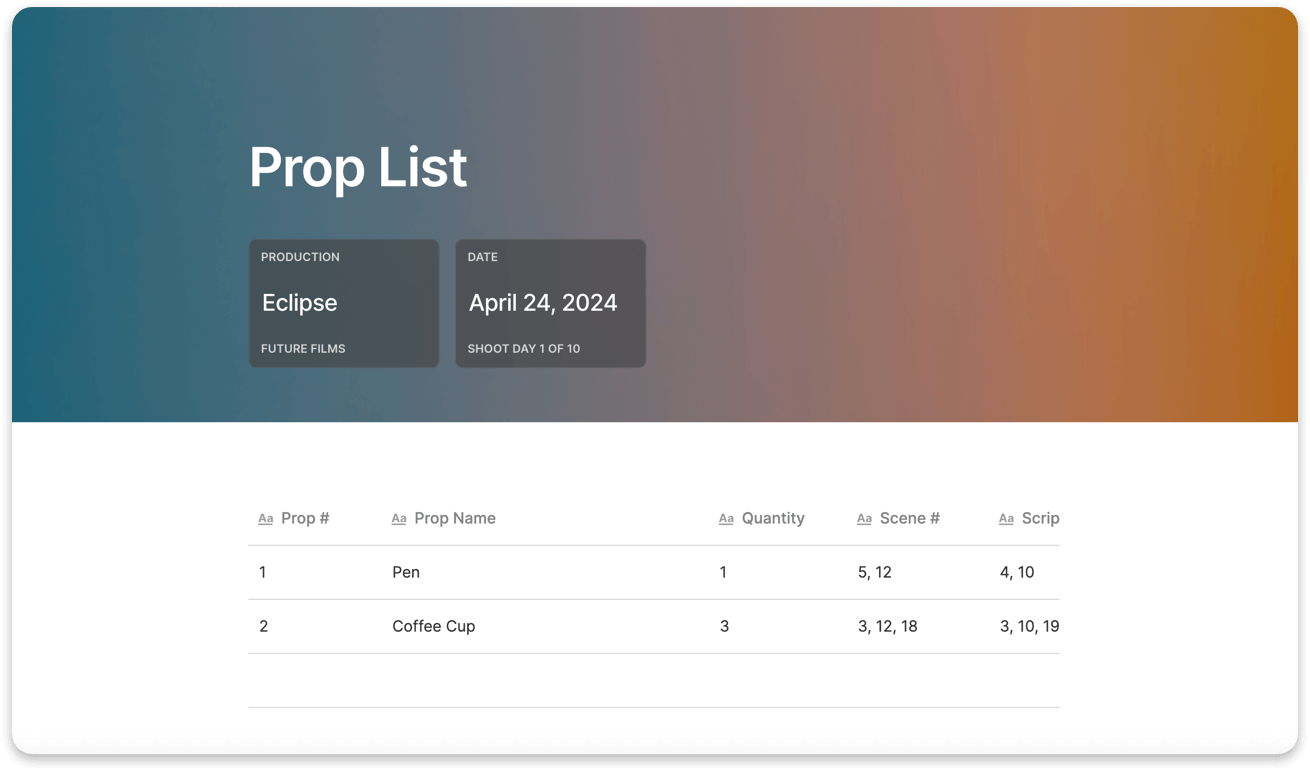
Prop List Template
Use this prop list template to track and organize all the props for your shoot.
Get Template
According to Hindle, architects such as Eero Saarinen and Kevin Roche influenced the office set design. Alongside Andrew Baseman, the set decorator, Dan Erickson, the creator and writer of Severance, and Ben Stiller — yes, that Ben Stiller — who directed six of the show’s nine episodes, Hindle was able to design a set that encapsulated the vibe of the show. But before moving to set design, there’s another name of note: Jessica Lee Gagné, the cinematographer for most of the show. While she executed the look flawlessly, she originally wasn’t sold on the idea of shooting almost an entire show without natural lighting. It wasn’t until she came across several photography books, which captured office spaces and the people who work in offices, that she was inspired on how to tackle the show’s look, she told IndieWire.
The Dolly Zoom
With such a stylized show, it’s difficult to point out every shot and moment, but the elevator shot best highlights the duality of the show. The shot is an old Hollywood camera trick that the famous Alfred Hitchcock first popularized in the film Vertigo. The shot goes by many names: the Hitchcock shot, Vertigo shot, Zoom Dolly shot, or Zolly shot. Regardless of the name, the effect involves moving the camera, which is on a dolly, one way and zooming in or out the opposite way. Depending on how the effect is used, it can make the shot appear as if the background suddenly grows larger and more detailed, dwarfing the foreground, or it can make the subject in the foreground swallow up the frame as it grows larger.
.jpg?width=1600&name=dolly%20zoom%20(1).jpg) The dolly zoom rig used to film the elevator scene. Image via AppleTV+ (Go Creative Show).
The dolly zoom rig used to film the elevator scene. Image via AppleTV+ (Go Creative Show).
The elevator is a physical transition between the outside world and the underground world of Lumon. The trip in the elevator is not your typical ride; it’s the trigger that switches the two different personas, so the show needed to communicate the massive change by executing a very obvious visual change. So, to sell the change, the dolly zoom is the visual representation of that transition. It merges the traditional TV show camera style of the outside world with the more surveillance-inspired look used to shoot inside Lumon. When the characters travel down the elevator, the dolly zoom shot makes the background fade as the character’s faces in the foreground grow wider, changing their facial features. Conversely, as they ride up, the background grows larger, and the character’s faces narrow to their original width. The clip below is a collection of dolly zoom shots from the show.
.jpg?width=1600&name=picture%202%20(1).jpg) The use of the dolly zoom shot widens Mark’s features as he rides down the elevator. Image via AppleTV+.
The use of the dolly zoom shot widens Mark’s features as he rides down the elevator. Image via AppleTV+.
The Lighting of Lumon
Although Gagné was wary of being the DP on Severance because she felt lighting an office would too limiting, she eventually came around to the idea. Working with Hindle, she was able to find the right lighting that would work for the set and the show. In an interview with Variety, Gagné said they tried to make the lighting in each room as complex as possible. She ended up using Sony’s Venice camera to bring out the highlights in the color, which owners of HDR TVs would definitely appreciate. To get the most out of each scene, Gagné and her lighting team would experiment with lighting. These “lighting workouts,” as she called them, allowed the team to get creative and get to know each other better. And it paid off.
While Gagné and Stiller fussed with the overhead lights of the MDR office for the now-infamous Music Dance Experience (MDE) scene, the gaffer found out the dimmer board for the lights could create a strobe effect, which Gagné absolutely loved and decided to use. The decision to use the lights made up for the ugly green carpet, but it took the better part of a month to program the lights. In the end, the hard work paid dividends — it’s one of the most memorable scenes in a show made up of memorable scenes. And the colorful strobe lights did more than set the tone for the scene, they actually garnered genuine awe and surprise from the actors, who were, up to that point, unaware the lights could do that. Scott revealed this behind-the-scenes fact during Late Night with Seth Meyers. “We had no idea that was gonna happen, so the reaction you see of us, kind of marveling at these lights, are actual actors that have been trapped in this room for nine months being dazzled by disco lights,” Scott said.
While Gagné’s decision to use the strobe lights turned out great, not every one of her decisions was approved right away. She had to fight for the lighting in some scenes. For example, going back to the MDE scene, there’s a point where the once-joyful scene begins to grow tense as Mr. Milchik dances around the sulking Dylan. For this scene, Stiller and Gagné had different ideas for the color of the lighting, with Stiller going for red and Gagné opting for orange. The compromise was a reddish-orange, sort of coppery, color that really brought out the shadows in the scene. Another lighting battle with stiller involved the pink-lit scene with Mark and Helly, which Gagné argued needed to be pink because it was a romantic scene. She ultimately got her way, again proving to be the right decision. As she put it to Mashable, it was the show’s Wong Kar-Wai scene.
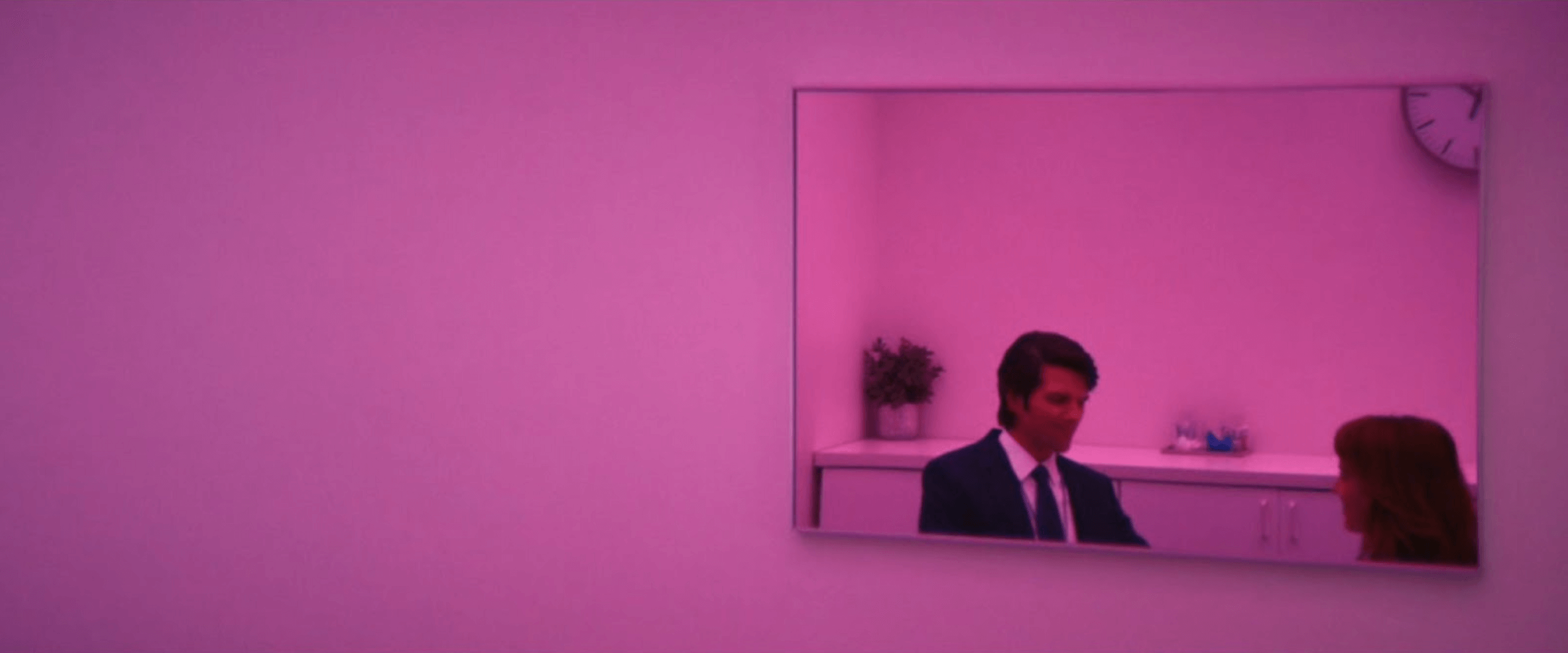 The scene in the episode “What’s for Dinner.” Image via AppleTV+
The scene in the episode “What’s for Dinner.” Image via AppleTV+
Still, even smaller battles occurred, such as one with the production design team, when she asked the team to place lamps on the desks so she could use them as practicals. Though the practicals wouldn’t be used in every scene, she needed them there in case a scene asked for different lighting. The production design team had to concede, although they were going for a minimalist desk design, and it wasn’t for nothing — there’s a pivotal scene that uses the practical lighting.
How They Designed the Set
Nothing sells the dystopian corporate atmosphere more than the maze of seemingly infinite white hallways. According to Hindle, the set for Severance was built on three soundstages which ran 130 feet long, giving the team plenty of room to capture long shots of characters walking to and from the various mysterious rooms within the Lumon offices. The only reprieve from the white hallways is the occasional piece of art, which depicts the founder of Lumon, Kier Egan, as some sort of savior. The pieces are unsettling, like most everything else inside Lumon, but it justifies the existence of Lumon’s Optics and Design department, which is essentially tasked with creating corporate swag and propaganda.
.jpg?width=1600&name=pitcure%204%20(1).jpg) The four-person desk is the only seating area on the entire MDR office floor. It really stands out against the dull green carpet. Image via AppleTV+.
The four-person desk is the only seating area on the entire MDR office floor. It really stands out against the dull green carpet. Image via AppleTV+.
When Mark, played by Adam Scott, and his coworkers are not walking about the hallways, they’re working in the Macro Data Refinement (MDR) office. What MDR employees do and how they do it is not clear. However, the office is like any other workplace, with the occasional small talk, trash talk, and gossip. What does stand out is there are no cubicles, as you might expect for a workplace as corporate as this. Instead, the characters sit adjacent to each other in the middle of a cavernous office space that serves to emphasize the closeness of the seating arrangements. The visual language of the MDR office is a metaphor for the large, enigmatic Lumon, which surrounds the MDR team from each angle. The room, with its green carpeting and oppressive white lighting, is at once a sterile workplace and inconspicuously hostile. Hindle said the green carpet chosen was one of six tested, and though it’s “really horrific,” it’s the one that worked best with the grading and affected the viewer the least.
.jpg?width=1600&name=picture%205%20(1).jpg) The desk is surrounded by green carpet and white walls and low ceilings with intense fluorescent lights. Image via AppleTV+.
The desk is surrounded by green carpet and white walls and low ceilings with intense fluorescent lights. Image via AppleTV+.
One room that is unlike the others is the Wellness room. If the MDR office is a minimalist blank canvas in the liminal space between an office and an empty department store, the Wellness room is an ostensibly relaxing, cozy environment. With a tree situated in the middle of the room, dimmed circular lights above, comfortable chairs, and dark wooden walls, the Wellness room is supposed to be disarming. It’s the closest thing that employees have to HR. Inside the room, Ms. Casey conducts a therapy session, lifting the spirits of employees by telling them facts about their “outie” — the persona that lives exclusively outside of Lumon. The tonal whiplash of the Wellness room in relation to the rest of the Lumon office highlights the oddity of the room in an already odd workplace. In addition to looking different, it’s the only place employees learn about their true personas; it’s the closest they can get to the outside world without leaving Lumon. That’s why the Wellness room looks like something that could exist in the outside world.
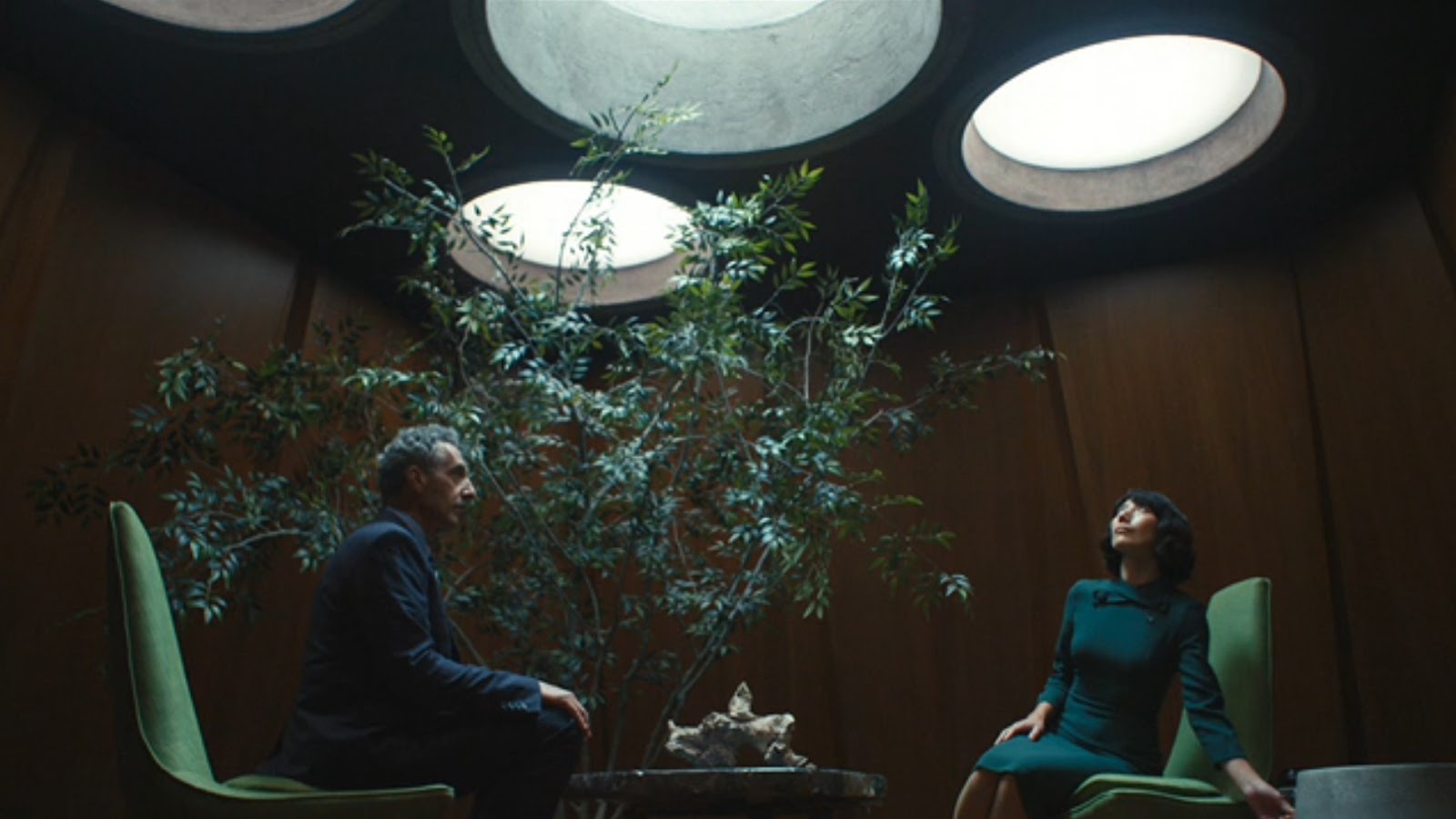 The Wellness room is much different from the rest of Lumon’s underground office. Image via AppleTV+.
The Wellness room is much different from the rest of Lumon’s underground office. Image via AppleTV+.
On the other hand, there’s the break room, which has a very different meaning from what you might expect. The break room — emphasis on “break” — is where Mr. Milchik takes rowdy Lumon employees and asks them to repeat an apology over and over until he’s satisfied the apology is sincere. To go into the break room, employees first pass through a dimly-lit narrow hallway that’s barely wide enough for one person, setting the tone for what’s about to happen. The actual break room is also dimly lit. Long gone are the fluorescent lights of the hallway, instead replaced by a single light source, which is a transparent projector screen that displays the apology text. It’s a dismal experience that breaks employees. When they finally exit the room after hours-long sessions, they have sunken eyes and haggard expressions, so it makes sense that the break room looks the way it does.
.jpg?width=1600&name=picture%207%20(1).jpg) It’s not until after someone steps through the door that the lens focuses on the name of the room. Image via AppleTV+.
It’s not until after someone steps through the door that the lens focuses on the name of the room. Image via AppleTV+.
.jpg?width=1600&name=picture%208%20(1).jpg) Everything about this hallway leads one to believe what’s waiting at the end won’t be pleasant. Image via AppleTV+.
Everything about this hallway leads one to believe what’s waiting at the end won’t be pleasant. Image via AppleTV+.
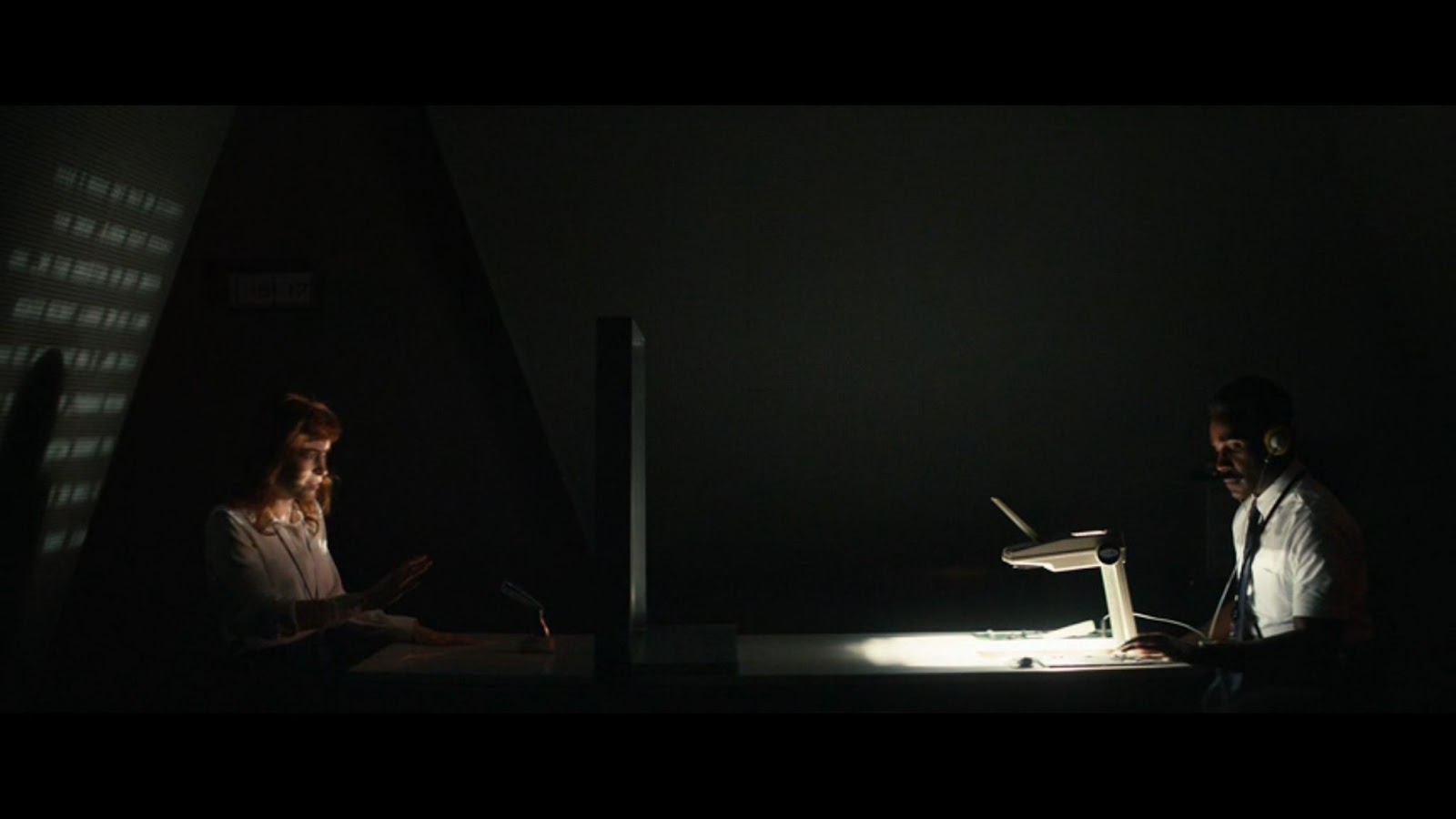
 The break room is small, barely lit, and designed like an interrogation room. Image via AppleTV+.
The break room is small, barely lit, and designed like an interrogation room. Image via AppleTV+.
.jpg?width=1600&name=red%20(1).jpg) Ben Stiller directing the break room scene. Image via AppleTV+ (Go Creative Show).
Ben Stiller directing the break room scene. Image via AppleTV+ (Go Creative Show).
Creating the Lumon Props
The setting of Severance is a character unto itself, with many layers to explore. But it’s the props used in the show that do a lot of the heavy lifting when it comes to world-building. The props sell the notion of Lumon being a walled-off garden that exists in a timeless vacuum. Baseman admitted to Vulture that props such as lamps and other office appliances and furniture were either bought or made abroad so they would be unrecognizable to most viewers. All you have to do is look at the computers used in the show to know you’re not in the “real” world.
 The Lumon keyboard and mouse are one piece and branded with Lumon’s colors. Image via AppleTV+.
The Lumon keyboard and mouse are one piece and branded with Lumon’s colors. Image via AppleTV+.
Severance turns an office worker’s most basic tool, the computer, into a device that looks familiar enough to anyone that’s ever used one, but also looks like vaporware. Hindle and Basemand, the set decorator, decided to go with a custom-made computer because viewers would be able to recognize every other computer they brought in. In the end, they ended up with a computer that looked like it was made in the 80s, albeit with modern features. Again the show’s duality emerges, as the cathode-ray tube monitor, which is an ancient technology at this point, is also a touchscreen. The computer also uses a trackball instead of a mouse, and the keyboard lacks an escape key, a metaphor for Lumon’s employees not being able to escape the office.
.jpg?width=1600&name=green%20(1).jpg) Dylan (played by Zach Cherry) likes to display his incentive rewards, all of which were specifically made and chosen to fit the Lumon aesthetic. Image via AppleTV+ (Go Creative Show).
Dylan (played by Zach Cherry) likes to display his incentive rewards, all of which were specifically made and chosen to fit the Lumon aesthetic. Image via AppleTV+ (Go Creative Show).
The desk the computers sat on was also custom-made. Gagné revealed it cost $100,000 to get the desk made. Hindle and props master Cat Miller are to thank for the unique desk design. Apart from the computers, each employees’ desk area had very few personal items to distinguish it from the others. Hindle said in an interview with IndieWire they wanted to go back to the times when office desks weren’t packed full of mementos and personal items like family photos. Instead of personal items on their desks, Lumon employees’ desks are decorated with the incentives received from completing their work. The incentives are random objects: finger traps, erasers, 3D glass portraits, and office supplies. To give the impression that Lumon made the props, they all had a distinct powder blue, Lumon-branded look.
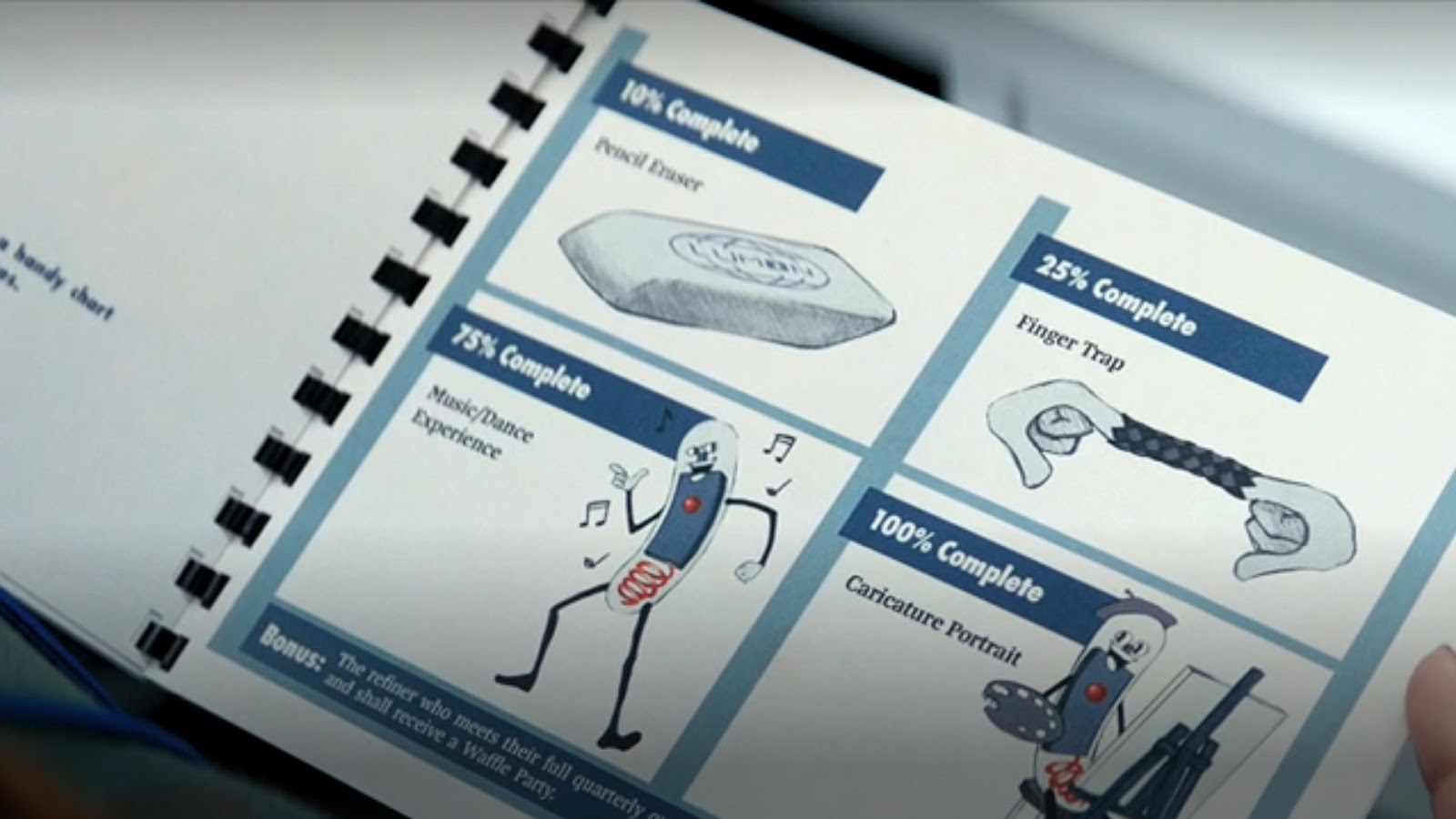
.jpg?width=1600&name=picture%2013%20(1).jpg)
.jpg?width=1600&name=picture%2014%20(1).jpg) All the incentives and desk tchotchkes are in line with Lumon’s branding.
All the incentives and desk tchotchkes are in line with Lumon’s branding.
Making a Show in the Pandemic
It’s clear that Severance is saying something about the modern workplace and corporations. Especially now, in the wake of the great resignation, Severance strikes a chord, but it was a show that was entirely conceived before the pandemic and which was scheduled to begin shooting three weeks after the initial lockdown in 2020. The pandemic delayed production until October 2020, but it was derailed several more times whenever someone turned up with Covid-19, including Scott.
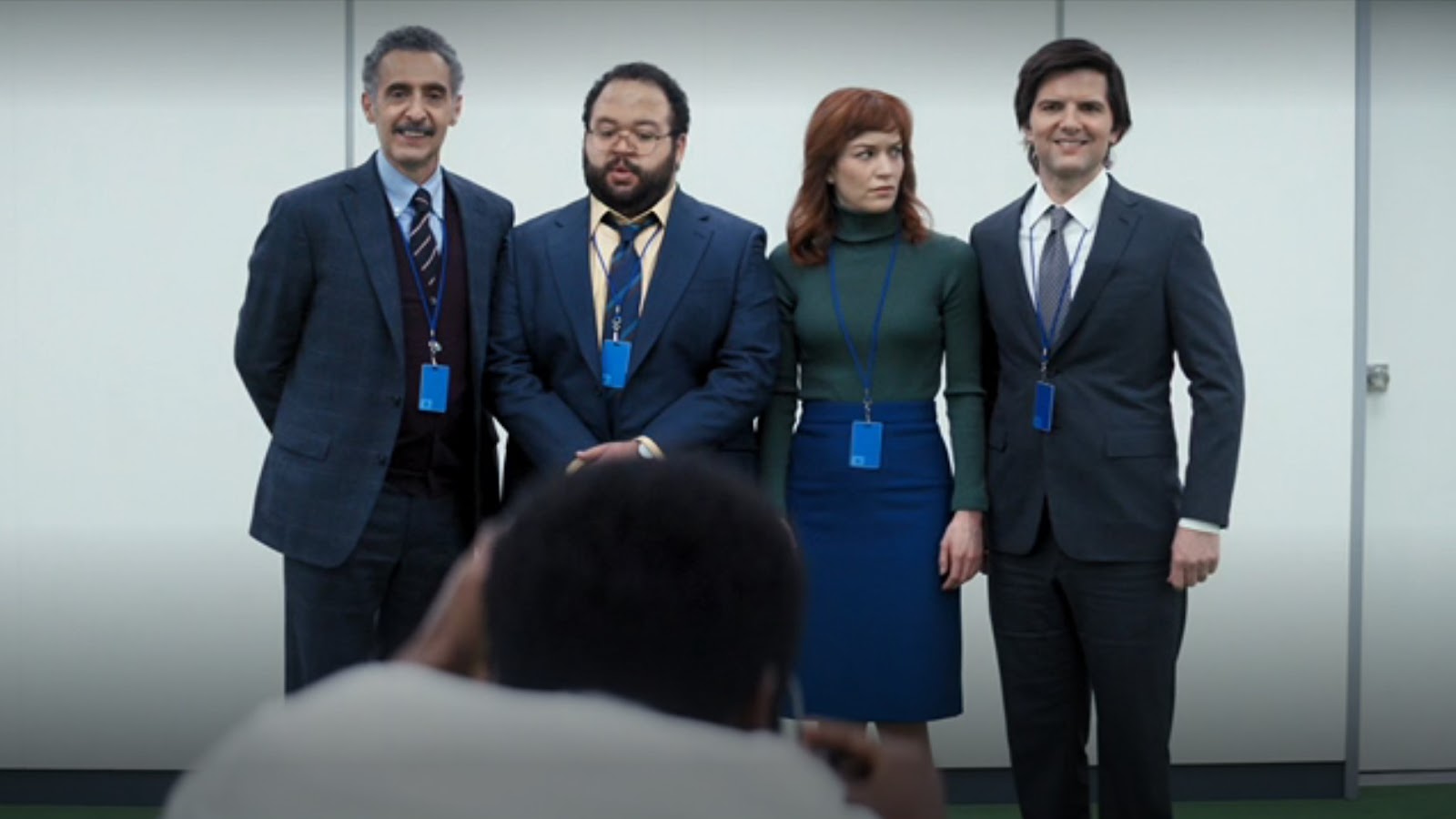 Tramell Tillman, who plays Mr. Milchik, learned how to use a film camera to capture the MDR team’s group photo for this scene. Image via AppleTV+.
Tramell Tillman, who plays Mr. Milchik, learned how to use a film camera to capture the MDR team’s group photo for this scene. Image via AppleTV+.
The show eventually finished filming after nine months and was released earlier this year on Apple TV+. It’s received such praise and adoration that it’s already been renewed for a second season, though Stiller and Scott have admitted in separate interviews that they weren’t sure people would understand what Severance was trying to do. Granted, it’s a heady show, but it reflects and amplifies the worse parts of modern work culture, which anyone who’s ever clocked in can understand. It’s expertly shot, with set and prop design work that builds the world of Lumon and sets a solid foundation for everything else. What’s not to get?

